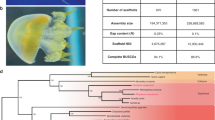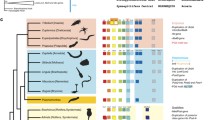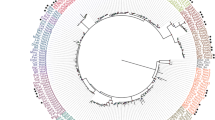Abstract
We report the recovery of homologs of Six1/2/sine oculis (so), a homeodomain-containing member of the Six-gene family, from a diverse set of basal Metazoa, including representatives of the poriferan classes Demospongia, Calcarea and Hexactinellida, the cnidarian classes Hydrozoa, Scyphozoa and Anthozoa, as well as a ctenophore. so sequences were also recovered from a platyhelminth, an echiurid and two bivalve molluscs, members of the super-phyletic group Lophotrochozoa. In the case of the platyhelminth, multiple distinct so sequences were recovered, as well as a member of the related group Six4/5/D-Six4. Extended sequences of the so gene were recovered from the demosponge, Haliclona sp., and the scyphozoan Aurelia aurita via PCR, and 3′ RACE. The affinities of all recovered sequences were assessed using a parsimony analysis based on both nucleic and amino acid sequence and using successive character weighting. Our results indicate that so is highly conserved across the animal kingdom. Preliminary expression data for Aurelia reveal that transcripts of the so homolog are present in the manubrium as well as in the rhopalia, which contain the statocyst and eyes, in the free-swimming ephyra and juvenile stages of these jellyfish.




Similar content being viewed by others
References
Agosti D, Jacobs DK, DeSalle R (1996) On combining protein and nucleic acid sequences in phylogenetic analysis: the homeobox protein case. Cladistics 12:65–82
Arai MN (1997) A functional biology of the Scyphozoa. Chapman and Hall, London, pp 30–78
Arendt D, Tessmar K, de Campos-Baptista MM, Dorresteijn A, Wittbrodt J (2002) Development of pigment-cup eyes in the polychaete Platynereis dumerilii and evolutionary conservation of larval eyes in Bilateria. Development 129:1143–1154
Boucher CA, Carey N, Edwards YH, Siciliano MJ, Johnson KJ (1996) Cloning of the human Six1 gene and it’s assignment to chromosome 14. Genomics 33:140–142
Bovolenta P, Mallamaci A, Puelles L, Boncinelli E (1998) Expression pattern of cSix3, a member of the Six/sine oculis family of transcription factors. Mech Dev 70:201–203
Chen P, Johnson JE, Zoghbi HY, Segil N (2002) The role of Math1 in inner ear development: uncoupling the establishment of the sensory primordium from hair cell fate determination. Development 129:2495–2505
Cheyette BNR, Green PJ, Martin K, Garren H, Hartenstein V (1994) The Drosophila sine oculis locus encodes a homeodomain-containing protein required for the development of the entire visual system. Neuron 12:977–996
Dawson MN, Jacobs DK (2001) Molecular evidence for cryptic species of Aurelia aurita (Cnidaria, Scyphozoa). Biol Bull 200:92–96
Degnan BM, Degnan SM, Giusti A, Morse DE (1995) A hox/hom homeobox gene in sponges. Gene 155:175–177
Dozier C, Kagoshima H, Niklaus G, Cassata G, Burglin TR (2001) The Caenorhabditis elegans Six/sine oculis class homeobox gene ceh-32 is required for head morphogenesis. Dev Biol 236:289–303
Finnerty JR, Pang K, Burton P, Martindale MQ (2003) The evolution of key bilaterian traits: insights into axial patterning and mesoderm formation from the sea anemone Nematostella, a non-bilaterian animal. Dev Biol 259(2):716
Ghanbari H, Seo HC, Fjose A, Brandli AW (2001) Molecular cloning and embryonic expression of Xenopus Six homebox genes. Mech Dev 101(1–2):271–277
Gopfert MC, Stocker H, Robert D (2002) Atonal is required for exoskeletal joint formation in the Drosophila auditory system. Dev Dyn 225(1):106–110
Gorbman A (1995) Olfactory origins and evolution of the brain-pituitary endocrine system: facts and speculation. Gen Comp Endocrinol 97:171–178
Gregory TR, Hebert PDN, Kolasa J (2000) Evolutionary implications of the relationship between genome size and body size in flatworms and copepods. Heridity 84:201–208
Halder G, Callerts P, Flister S, Walldorf U, Kloter U, Gehring W (1998) Eyeless initiates the expression of both sine oculis and eyes absent during Drosophila compound eye development. Development 125:2181–2191
Hammond KL, Hill RE, Whitfield TT, Currie PD (2002) Isolation of three zebrafish dachshund homologues and their expression in sensory organs, the central nervous system and pectoral fin buds. Mech Dev 112(1–2):183–189
Hassan J, Busto M, Iyengar B, Campos AR (2000) Behavioral characterization and genetic analysis of the Drosophila melanogaster larval response to light as revealed by a novel individual assay. Behav Genet 30(1):59–69
Heath SK, Carne S, Hoyle C, Johnson KJ, Wells DJ (1997) Characterization of expression of mDMAHP, a homeodomain-containing gene at the murine DM locus. Hum Mol Genet 6:651–657
Irisawa H, Irisawa T, Nishida Y (1956) Responses of the receptor of a medusa Aurelia aurita to light stimuli (in Japanese). Kagaku Nan’yo 26:312–313
Jacobs DK, Gates RD (2003) Developmental genes and reconstruction of Metazoan evolution—implications of evolutionary loss, limits of inference of ancestry and type 2 errors. Integr Comp Biol 43:11–18
Jarman AP, Sun Y, Jan LY, Jan YN (1995) Role of the proneural gene, atonal, in formation of Drosophila chordotonal organs and photoreceptors. Development 121:2019–2030
Kawakami K, Sato S, Ozaki H, Ikeda K (2000) Six family genes—structure and function as transcription factors and their roles in development. Bioessays 22:616–626
Kirby RJ, Hamilton GM, Finnegan DJ, Johnson KJ, Jarman AP (2001) Drosophila homolog of the myotonic dystrophy-associated gene, SIX5, is required for muscle and gonad development. Curr Biol 11:1044–1049
Kruse M, Mikoc A, Cetkovic H, Gamulin V, Rinkevich B, Müller IM, Müller WEG (1994) Molecular evidence for the presence of a developmental gene in the lowest animal: identification of a homeobox-like gene in the sponge Geodia cydonium. Mech Ageing Dev 77(1):43–54
Laclef C, Hamard G, Demignon J, Souil E, Houbron C, Maire P (2003a) Altered myogenesis in Six1-deficient mice. Development 130:2239–2252
Laclef C, Souil E, Demignon J, Maire P (2003b) Thymus, kidney and craniofacial abnormalities in Six1 deficient mice. Mech Dev 120:669–679
Lawn ID, Mackie GO, Silver G (1981) Conduction system in a sponge. Science 211(4487):1169–1171
Lee SE, Gates RD, Jacobs DK (2003) Gene fishing: the use of a simple protocol to isolated multiple homeodomain classes from diverse invertebrate taxa. J Mol Evol 56:509–516
Leys SP, Mackie GO, Meech RW (1999) Impulse conduction in a sponge. J Exp Biol 202:1139–1150
Leys SP, Cronin TW, Degnan BM, Marshall JN (2002) Spectral sensitivity in a sponge larva. J Comp Physiol A 188(3):199–202
Loosli F, Winkler S, Wittbrodt J (1999) Six3 overexpression initiates the formation of ectopic retina. Genes Dev 13:649–654
Maddison WP, Maddision DR (1999) MacClade: analysis of phylogeny and character evolution. Version 3.08. Sinauer, Sunderland, Mass.
Manuel M, Le Parco Y (2000) Homeobox gene diversification in the calcareous sponge Sycon raphanus. Mol Phylogenet Evol 17:97–107
McCauley DW, Bronner-Fraser M (2002) Conservation of Pax gene expression in ectodermal placodes of the lamprey. Gene 287(1–2):129–139
Nederbragt AJ, van Loon AE, Dictus WJAG (2002) Expression of Patella vulgata orthologs of engrailed and dpp-BMP2/3 in adjacent domains during molluscan shell development suggests a conserved compartment boundary mechanism. Dev Biol 246:341–355
Nikko E, Van de Vyver G, Richelle-Maurer E (2001) Retinoic acid down-regulates the expression of EmH-3 homeobox-containing gene in the freshwater sponge Ephydatia muelleri. Mech Ageing Dev 122:779–794
O’Brien EK, Degnan BM (2002) Developmental expression of a class IVPOU gene in the gastropod Haliotis asinina supports a conserved role in sensory cell development in bilaterians. Dev Genes Evol 212:394–398
Ohto H, Takizawa T, Saito T, Kobayashi M, Ikeda K, Kawakami K (1998) Tissue and developmental distribution of Six family gene products. Int J Dev Biol 42:141–148
Oliver G, Wehr R, Jenkins N, Copeland NG, Cheyette BN, Hartenstein V, Zipursky SL, Gruss P (1995a) Homeobox genes and connective tissue patterning. Development 121:693–705
Oliver G, Mailhos A, Wehr R, Copeland N, Jenkins N, Gruss P (1995b) Six3, a murine homologue of the sine oculis gene, demarcates the most anterior border of the developing neural plate and is expressed during eye development. Development 121:4045–4055
Passano LM (1982) Electrical conduction and behaviour in “simple” invertebrates. Scyphozoa and Cubozoa. In: Shelton GAB (ed) Oxford University Press, Oxford, pp 149–202
Pignoni F, Hu B, Zavitz KH, Xiao J, Garrity PA, Zipursky SL (1997) The eye-specification proteins so and eya form a complex and regulate multiple steps in Drosophila development. Cell 91:881–891
Pineda D, Gonzales J, Callerts P, Ikeo K, Gehring WJ, Salo E (2000) Searching for the prototypic eye genetic network: sine oculis is essential for eye regeneration in planarians. Proc Natl Acad Sci USA 97(9):4525–4529
Reiswig HM (1971) In situ pumping activities of tropical Demospongiae. Mar Biol 9:38–50
Richelle-Maurer E, Van de Vyver G (1999) Temporal and spatial expression of EmH-3, a homeobox-containing gene isolated from the freshwater sponge Ephydatia muelleri. Mech Ageing Dev 109:203–219
Sanger F, Nicklen S, Coulson RE (1977) DNA sequencing with chain terminating inhibitors. Proc Natl Acad Sci USA 74:5463–5467
Schwab WE (1977) The ontogeny of swimming behavior in the Scyphozoan, Aurelia aurita. 1. Electrophysiological analysis. Biol Bull 152:233–250
Seimiya M, Gehring WJ (2000) The Drosophila homeobox gene optix is capable of inducing ectopic eyes by an eyeless-independent mechanism. Development 127:1879–1886
Seimiya M, Ishiguro H, Miura K, Watanabe Y, Kurosawa Y (1994) Homeobox-containing genes in the most primitive Metazoa, the sponges. Eur J Biochem 221:219–225
Seimiya M, Watanabe Y, Kurosawa Y (1997) Identification of POU-class homeobox genes in a freshwater sponge and the specific expression of these genes during differentiation. Eur J Biochem 243(1–2):27–31
Seo H, Curtiss J, Mlodzik M, Fjose A (1999) Six class homeobox genes in Drosophila belong to three distinct families and are involved in head development. Mech Dev 83:127–139
Serikaku MA, O’Tousa JE (1994) sine oculis is a homeobox gene required for Drosophila visual system development. Genetics 138:1137–1150
Spangenberg D (1968) Statolith differentiation in Aurelia aurtia. J Exp Zool 178:183–194
Spangenberg D (1991) Rhopalium development in Aurelia aurita ephyrae. Arobiologia 216/217:45–49
Spangenberg D, Phillips R, Kostas A (1989) Effect of gravireceptor excision in Aurelia ephyra swimming/pulsing behavior at 1 G and during flight. Am Soc Grav Space Biol 2:24
Spring J, Yanze N, Jösch C, Middel AM, Winninger B, Schmid V (2002) Conservation of Brachyury, Mef2, and Snail in the myogenic lineage of jellyfish: a connection to the mesoderm of Bilateria. Dev Biol 244 (2):372–384
Sun H, Rodin A, Zhou Y, Dickinson DP, Harper DE, Hewett-Emmett D, Li WH (1997) Evolution of paired domains: isolation and sequencing of jellyfish and hydra Pax genes related to Pax-5 and Pax-6. Proc Natl Acad Sci USA 94:5156–5161
Swafford DL (1998) PAUP*. Phylogenetic analysis using parsimony(*and other methods). Version 4. Sinauer, Sunderland, Mass.
Tomarev SI, Callaerts P, Kos L, Zinovieva R, Halder G, Gehring W, Piatigorsky J (1997) Squid Pax-6 and eye development. Proc Natl Acad Sci USA 94:2421–2426
Toy J, Yang J-M, Leppert GS, Sundin O (1998) The Optx2 homeobox gene is expressed in early precursors of the eye and activates retina-specific genes. Proc Natl Acad Sci USA 95:10643–10648
Wilson K (1987) Current protocols in molecular biology. Wiley, New York
Woollacott RM (1993) Structure and swimming behavior of the larva of Haliclona tubifera (Porifera: Domospongiae). J Morphol 218:301–321
Yamashita T (1957) Das Aktionspotential der Sinneskörper (Randkörper) der Meduse Aurelia aurita. Z Biol 109:116–122
Yoshida M, Yoshino Y (1980) Differentiation of ocelli in ephyrae of Aurelia aurita. In: Tardent P, Tardent T (eds) Developmental and cellular biology of Coelenterates. Elsevier/North Holland, Amsterdam, pp 343–346
Zheng W, Huang L, Wei Z, Silvius D, Tang B, Xu P (2003) The role of Six1 in mammalian auditory system development. Development 130:3989–4000
Acknowledgements
We would like to thank Shannon Lee for help with the phylogenetic analysis, Sally Leys for supplying hexactinellid material, Mike Schaadt of the Cabrillo Aquarium for providing Aurelia material and much help in the rearing of Aurelia, Vincent Levesque of the Birch Aquarium at Scripps for providing ephyrae and polyps for our cultures, Anthony Camara for sequencing COI, Alexander Nederbragt and Mark Martindale for providing the ctenophore sequence and NASA and NSF for grant support. This is HIMB contribution # 1182.
Author information
Authors and Affiliations
Corresponding author
Additional information
Edited by D. Tautz
Rights and permissions
About this article
Cite this article
Bebenek, I.G., Gates, R.D., Morris, J. et al. sine oculis in basal Metazoa. Dev Genes Evol 214, 342–351 (2004). https://doi.org/10.1007/s00427-004-0407-3
Received:
Accepted:
Published:
Issue Date:
DOI: https://doi.org/10.1007/s00427-004-0407-3




